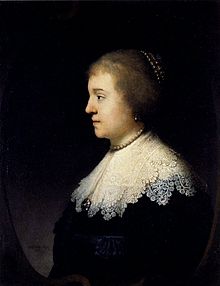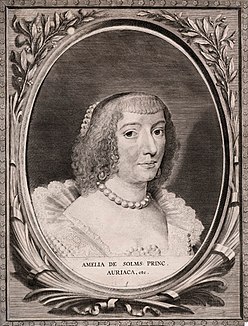Wikipedia
This text was copied from Wikipedia on 17 January 2025 at 5:10AM.
| Amalie of Solms-Braunfels | |
|---|---|
 Portrait by Gerard van Honthorst | |
| Princess consort of Orange | |
| Tenure | 1625–1647 |
| Born | (1602-08-31)31 August 1602 Braunfels Castle in Braunfels |
| Died | 8 September 1675(1675-09-08) (aged 73) the Hague |
| Spouse | Frederick Henry, Prince of Orange |
| Issue | William II, Prince of Orange Louise Henriette, Duchess of Prussia Henriette Amalia of Nassau Alexandra of Nassau Isabella Charlotte of Nassau Albertine Agnes, Countess of Nassau-Dietz Henriette Catherine, Princess of Anhalt-Dessau Henry Louis of Nassau Maria, Countess Palatine of Simmern-Kaiserslautern |
| House | Solms-Braunfels |
| Father | John Albert I, Count of Solms-Braunfels |
| Mother | Countess Agnes of Sayn-Wittgenstein |
Amalia of Solms-Braunfels (31 August 1602 – 8 September 1675) was Princess of Orange by marriage to Frederick Henry, Prince of Orange. She acted as the political adviser of her spouse during his reign, and acted as his de facto deputy and regent during his infirmity from 1640 to 1647. She also served as chair of the regency council during the minority of her grandson William III, Prince of Orange from 1650 until 1672.
Biography
Early life
Amalia was born in Braunfels as a fourth daughter of Imperial Count Johann Albrecht I of Solms-Braunfels (1563-1623) and his wife, Countess Agnes of Sayn-Wittgenstein (1568-1617). She was a member of the House of Solms, a ruling family with Imperial immediacy, and spent her childhood at Braunfels Castle.
She became part of the court of Elizabeth Stuart, Queen of Bohemia, wife of Frederick V of the Palatine, the "Winter King" of Bohemia. After imperial forces defeated Frederick V, she fled from Prague with the pregnant queen to the west. Shelter was denied to them along the way because the emperor forbade it as Frederick had been placed under an Imperial ban. Elizabeth went into labour during their flight and Amalia helped her with her delivery of Prince Maurice at Küstrin castle.
The end of their journey was The Hague, where stadtholder Maurice, Prince of Orange, uncle of the elector gave them asylum in 1621. They often appeared at his court, where Maurice's younger half-brother Frederick Henry, Prince of Orange became infatuated with Amalia in 1622. She refused to become his lover and held out for marriage. The two were closely related, in particular, first cousins once removed.[1]
When Maurice of Nassau died, he made his half-brother Frederick Henry promise to wed. Frederick married Amalia on 4 April 1625.
Wife to the Stadtholder


When Frederick Henry became stadtholder after the death of his half-brother Prince Maurice, his influence grew substantially, as did Amalia's. Together Frederick Henry and Amalia succeeded in expanding court life in The Hague. They had several palaces built, including Huis ten Bosch. Amalia was a great collector of art and amassed many jewels, which were inherited by her four surviving daughters. She was described as intelligent, arrogant and ambitious, not beautiful but with a fresh and appealing appearance.
Amalia was the prime mover of several royal marriages, including that of her son William III to Mary, Princess Royal and Princess of Orange (daughter of King Charles I of England) and of their daughters with several German princes.
The relationship between Amalia and Frederik Hendrik was described as happy, and Amalia is acknowledged to have acted as his political adviser.[2] From 1640 until his death in 1647, Frederik Hendrik's health (he suffered from gout and probably also from a form of Alzheimer's) made it increasingly difficult for him to participate in politics, and during these seven years, Amalia therefore effectively functioned as regent and stadtholder, maintaining diplomatic contacts and making political decisions on his behalf.[3] Her de facto political position was acknowledged and diplomats, aware of this, tried to influence her decisions by costly presents.[2] It was reportedly Amalia who was behind Frederik Hendrik's participation in the negotiations which was eventually to result in the Peace of Münster of 1648.[3] As a recognition, King Philip IV of Spain granted her the seigniory and castle of Turnhout in 1649.
In 1647, her spouse died and was succeeded as stadtholder and Prince of Orange by their son William II, Prince of Orange.
Regency
After the death of her son William II in 1650, her grandson William III (Prince William III of Orange and later also King William III of England) became prince of Orange. A regency council was appointed during his minority, and Amalia and her former daughter-in-law Mary Stuart fought over guardianship and thereby chairmanship of the regency council; the High Court of Holland and Zeeland finally granted both Mary and Amalia shared guardianship, and thereby shared part in the regency council of Orange.[3]
Amalia was supported against Mary by her son-in-law, the Elector of Brandenburg, and she was on good terms with the Grand Pensionary Johan de Witt, a relationship which did not change with the Act of Seclusion of 1654, barring the prince from all ancestral offices. When Mary died in 1660, Amalia in practice took sole control of the regency of her grandson.[3] She maintained good relations to De Witt even by the passing of the 1667 Eternal Edict, which abolished the office of stadholder entirely.[2] During this time she lived in the Oude Hof on the Noordeinde, maintaining her court and diplomatic contacts with royalty.[3]
In 1672, her grandson was declared an adult and his regency council thereby dismissed. Amalia retired and witnessed him becoming stadholder of Holland, Zeeland, Utrecht, Gelderland and Overijssel and captain-general of the Union. She died at her home in The Hague, aged 73.
Tributes

A wine from wine estate Solms-Delta in Franschhoek (South Africa) is named after Amalia of Solms-Braunfels. The wine honours the role played by her in Dutch political life. Her grandson, William III, King of England, provided refuge and support to thousands of French Huguenots after the revocation of the Edict of Nantes in 1685. Some 180 of these refugees, fleeing religious persecution, were relocated to the Cape and granted farms in Franschhoek. Here they laid the foundations of the modern South African wine industry.
Issue
- Stadtholder William II (1626–1650), married Mary of England
- Luise Henriette of Nassau (1627–1667), married Frederick William, Elector of Brandenburg
- Henriette Amalia of Nassau (1628), died in infancy
- Elisabeth of Nassau (1630), died shortly after birth
- Isabella Charlotte of Nassau (1632–1642), died in childhood
- Albertine Agnes of Nassau (1634–1696), married William Frederick, Count of Nassau-Dietz
- Henriette Catherine of Nassau (1637–1708), married John George II, Prince of Anhalt-Dessau
- Henry Louis of Nassau (1639), died in infancy
- Maria of Nassau (1642–1688), married Louis Henry Maurice, son of Louis Philip of Palatine-Simmern-Kaiserslautern
Ancestry
| Ancestors of Amalie of Solms-Braunfels | |||||||||||||||||||||||||||||||||||||||||||||||||||||||||||||||||||||||||||||||||||||||||||||||||||||||||||||||||||||||||||||||||||||||||||||||||||||||||||||||||||||||||||||||||||||||||||||||||||||||||||||||||||||||||||||||||||||||||||||||||||||||||||||||||||||||||||||||||||||||||
|---|---|---|---|---|---|---|---|---|---|---|---|---|---|---|---|---|---|---|---|---|---|---|---|---|---|---|---|---|---|---|---|---|---|---|---|---|---|---|---|---|---|---|---|---|---|---|---|---|---|---|---|---|---|---|---|---|---|---|---|---|---|---|---|---|---|---|---|---|---|---|---|---|---|---|---|---|---|---|---|---|---|---|---|---|---|---|---|---|---|---|---|---|---|---|---|---|---|---|---|---|---|---|---|---|---|---|---|---|---|---|---|---|---|---|---|---|---|---|---|---|---|---|---|---|---|---|---|---|---|---|---|---|---|---|---|---|---|---|---|---|---|---|---|---|---|---|---|---|---|---|---|---|---|---|---|---|---|---|---|---|---|---|---|---|---|---|---|---|---|---|---|---|---|---|---|---|---|---|---|---|---|---|---|---|---|---|---|---|---|---|---|---|---|---|---|---|---|---|---|---|---|---|---|---|---|---|---|---|---|---|---|---|---|---|---|---|---|---|---|---|---|---|---|---|---|---|---|---|---|---|---|---|---|---|---|---|---|---|---|---|---|---|---|---|---|---|---|---|---|---|---|---|---|---|---|---|---|---|---|---|---|---|---|---|---|---|---|---|---|---|---|---|---|---|---|---|---|---|---|---|---|
| |||||||||||||||||||||||||||||||||||||||||||||||||||||||||||||||||||||||||||||||||||||||||||||||||||||||||||||||||||||||||||||||||||||||||||||||||||||||||||||||||||||||||||||||||||||||||||||||||||||||||||||||||||||||||||||||||||||||||||||||||||||||||||||||||||||||||||||||||||||||||
References
- ^ https://www.genealogics.org/relationship.php?altprimarypersonID=I00000098&savedpersonID=&secondpersonID=I00000097&maxrels=1&disallowspouses=1&generations=8&tree=LEO&primarypersonID=I00000098
- ^ a b c djr (18 January 2018). "Digitaal Vrouwenlexicon van Nederland". resources.huygens.knaw.nl.
- ^ a b c d e djr (18 January 2018). "Digitaal Vrouwenlexicon van Nederland". resources.huygens.knaw.nl. Retrieved September 16, 2014.
External links
 Media related to Amalia of Solms-Braunfels at Wikimedia Commons
Media related to Amalia of Solms-Braunfels at Wikimedia Commons- The Correspondence of Amalia von Solms-Braunfels in EMLO
- County of Solms in German Wikipedia

1 Annotation
Third Reading
San Diego Sarah • Link
Amalia of Solms-Braunfels never expected to make a grand marriage, but she did when she went from lady-in-waiting to Princess Consort of Orange.
She was born the daughter of John Albert, Count of Solms-Braunfels and Countess Agnes of Sayn-Wittgenstein on 31 August, 1602.
Amalia grew up at the Palatine Court at Heidelberg and when Frederick V and Elizabeth Stuart were chosen to be King and Queen of Bohemia, Amalia travelled with them to Prague as Elizabeth’s lady in waiting.
The Bohemian adventure ended after a year and Amalia fled with Frederick V and Queen Elizabeth through Europe to The Hague.
At The Hague Amalia met Frederick Henry of Orange, who was a younger son of William II of Orange from his fourth marriage to Louise de Coligny. The Prince of Orange was Maurice, the son from William II’s first marriage to Anna of Egmont. Maurice was unmarried, and pressured his younger brother to get married to secure the dynasty.
Frederick Henry and Amalia had been involved since 1622 but she refused to become his mistress. They married days before Maurice died in 1625.
The courts of Elizabeth Stuart, Queen of Bohemia and Amalia, Princess of Orange, soon became competitive.
Amalia commissioned the building of Huis Ten Bosch and its main hall would eventually be completely dedicated to Frederick Henry. The so-called Orange Hall is not open to the public.
Amalia and Frederick Henry seem to have had a happy marriage. Although he had fathered an illegitimate son, none were born during his marriage. He had 9 legitimate children with Amalia, although only 5 lived to adulthood.
Amalia of Orange was ambitious in arranging good marriages for her children. Their only son, William II, married King Charles of England’s eldest daughter, Mary Stuart the Princess Royal.
Amalia forced her daughter, Louise Henriette, to marry Frederick William, Elector of Brandenburg, despite that she was in love with Henri-Charles de la Tremoille, Prince of Talmant.
Amalia became politically active as her husband began to suffer from gout and probably Alzheimer’s disease. Frederick Henry, Prince of Orange died in 1647 and was succeeded by his son, William II.
Sadly William II died 3 years later of smallpox leaving an only son, another William, who was born a week after his death. Mary Stuart, Princess Royal and Princess of Orange, initially retained custody, but grandma Amalia was not pleased.
When Mary Stuart died in 1660, Amalia of Orange took over care of William III.
Amalia was an intelligent woman, although she wrote in phonetic German and French. She was not considered beautiful, but was ambitious and proud.
She died at 73 on 8 September 1675, and did not live to see her grandson become King of England. She is buried in the Nieuwe Kerk in Delft.
http://www.historyofroyalwomen.co…